
Vanadinite is a mineral belonging to the apatite group of phosphates, with the chemical formula Pb5(VO4)3Cl. It is one of the main industrial ores of the metal vanadium and a minor source of lead. A dense, brittle mineral, it is usually found in the form of red hexagonal crystals. It is an uncommon mineral, formed by the oxidation of lead ore deposits such as galena. First discovered in 1801 in Mexico, vanadinite deposits have since been unearthed in South America, Europe, Africa, and North America.
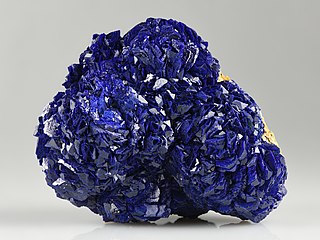
Azurite is a soft, deep-blue copper mineral produced by weathering of copper ore deposits. During the early 19th century, it was also known as chessylite, after the type locality at Chessy-les-Mines near Lyon, France. The mineral, a basic carbonate with the chemical formula Cu3(CO3)2(OH)2, has been known since ancient times, and was mentioned in Pliny the Elder's Natural History under the Greek name kuanos (κυανός: "deep blue," root of English cyan) and the Latin name caeruleum. Copper (Cu2+) gives it its blue color.
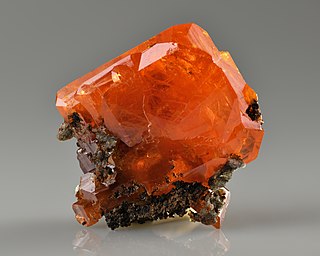
Wulfenite is a lead molybdate mineral with the formula PbMoO4. It can be most often found as thin tabular crystals with a bright orange-red to yellow-orange color, sometimes brown, although the color can be highly variable. In its yellow form it is sometimes called "yellow lead ore".

Mimetite is a lead arsenate chloride mineral (Pb5(AsO4)3Cl) which forms as a secondary mineral in lead deposits, usually by the oxidation of galena and arsenopyrite. The name derives from the Greek Μιμητής mimetes, meaning "imitator" and refers to mimetite's resemblance to the mineral pyromorphite. This resemblance is not coincidental, as mimetite forms a mineral series with pyromorphite (Pb5(PO4)3Cl) and with vanadinite (Pb5(VO4)3Cl). Notable occurrences are Mapimi, Durango, Mexico and Tsumeb, Namibia.

Tsumeb is a city of 15,000 inhabitants and the largest town in the Oshikoto region in northern Namibia. Tsumeb is known as the "gateway to the north" of Namibia. It is the closest town to the Etosha National Park. Tsumeb used to be the regional capital of Oshikoto until 2008 when Omuthiya was proclaimed a town and the new capital. The area around Tsumeb forms its own electoral constituency and has a population of 44,113. The town is the site of a deep mine that in its heyday was known as "TCL", but has since been renamed the Ongopolo Mine.

Descloizite is a rare mineral species consisting of basic lead and zinc vanadate, (Pb, Zn)2(OH)VO4, crystallizing in the orthorhombic crystal system and isomorphous with olivenite. Appreciable gallium and germanium may also be incorporated into the crystal structure.
Geigerite is a mineral, a complex hydrous manganese arsenate with formula: Mn5(AsO3OH)2(AsO4)2·10H2O. It forms triclinic pinacoidal, vitreous, colorless to red to brown crystals. It has a Mohs hardness of 3 and a specific gravity of 3.05.

Arthurite is a mineral composed of divalent copper and iron ions in combination with trivalent arsenate, phosphate and sulfate ions with hydrogen and oxygen. Initially discovered by Sir Arthur Russell in 1954 at Hingston Down Consols mine in Calstock, Cornwall, England, arthurite is formed as a resultant mineral in the oxidation region of some copper deposits by the variation of enargite or arsenopyrite. The chemical formula of Arthurite is CuFe23+(AsO4,PO4,SO4)2(O,OH)2·4H2O.

Duftite is a relatively common arsenate mineral with the formula CuPb(AsO4)(OH), related to conichalcite. It is green and often forms botryoidal aggregates. It is a member of the adelite-descloizite Group, Conichalcite-Duftite Series. Duftite and conichalcite specimens from Tsumeb are commonly zoned in color and composition. Microprobe analyses and X-ray powder-diffraction studies indicate extensive substitution of Zn for Cu, and Ca for Pb in the duftite structure. This indicates a solid solution among conichalcite, CaCu(AsO4 )(OH), austinite, CaZn(AsO4)(OH) and duftite PbCu(AsO4)(OH), all of them belonging to the adelite group of arsenates. It was named after Mining Councilor G Duft, Director of the Otavi Mine and Railroad Company, Tsumeb, Namibia. The type locality is the Tsumeb Mine, Tsumeb, Otjikoto Region, Namibia.

Plumbogummite is a rare secondary lead phosphate mineral, belonging to the alunite supergroup of minerals, crandallite subgroup. Some other members of this subgroup are:
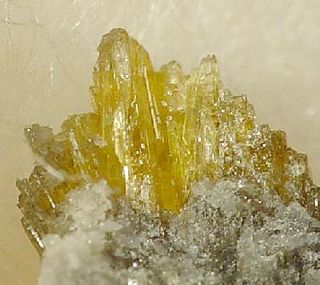
Warikahnite is a rare zinc arsenate mineral of the triclinic crystal system with Hermann- Mauguin notation 1, belonging to the space group P1. It occurs in the Tsumeb mine in Namibia on corroded tennantite in the second oxidation zone under hydrothermal conditions in a dolomite-hosted polymetallic ore deposit. It is associated with adamite, stranskiite, koritnigite, claudetite, tsumcorite, and ludlockite. The origin of discovery was in a dolomite ore formation within an oxidized hydrothermal zone, in the E9 pillar, 31st level of the Tsumeb Mine in Namibia, Southwest Africa. It has also been found at Lavrion, Greece and Plaka, Greece as microscopic white needles.

Tsumcorite is a rare hydrated lead arsenate mineral that was discovered in 1971, and reported by Geier, Kautz and Muller. It was named after the TSUMeb CORporation mine at Tsumeb, in Namibia, in recognition of the Corporation's support for mineralogical investigations of the orebody at its Mineral Research Laboratory.
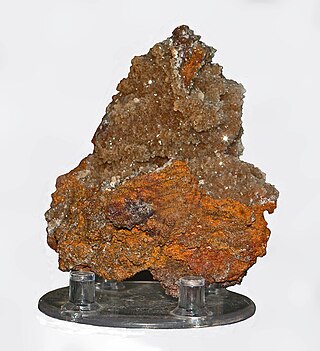
Tarbuttite is a rare phosphate mineral with formula Zn2(PO4)(OH). It was discovered in 1907 in what is now Zambia and named for Percy Coventry Tarbutt.
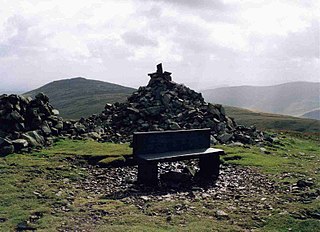
Ianbruceite is a rare hydrated zinc arsenate with the formula [Zn2(OH)(H2O)(AsO4)](H2O)2; material from the Driggith mine has traces of cobalt. It was first discovered at Tsumeb, approved by the International Mineralogical Association as a new mineral species in 2011, reference IMA2011-49, and named for Ian Bruce, who founded "Crystal Classics" in the early 1990s, and was heavily involved in attempts to reopen the famous Tsumeb mine for specimen mining.
In 2013 new occurrences of ianbruceite were reported from the neighbouring Driggith and Potts Gill mines on High Pike in the Caldbeck Fells, Cumbria, England. Here the mineral is probably a post-mining product. Caldbeck Fells and Tsumeb are the only reported localities for ianbruceite to date (May 2013).

Hidalgoite, PbAl3(AsO4)(SO4)(OH)4, is a rare member of the beudantite group and is usually classified as part of the alunite family. It was named after the place where it was first discovered, the Zimapán mining district, Hidalgo, Mexico. At Hidalgo where it was initially discovered, it was found as dense white masses in alternating dikes of quartz latite and quartz monzonite alongside other secondary minerals such as sphalerite, arsenopyrite, cerussite and trace amounts of angelsite and alamosite, it was then rediscovered at other locations such as Australia where it occurs on oxidized shear zones above greywacke shales especially on the anticline prospects of the area, and on fine grained quartz-spessartine rocks in Broken Hill, Australia. Hidalgoite specimens are usually associated with copper minerals, clay minerals, iron oxides and polymetallic sulfides in occurrence.
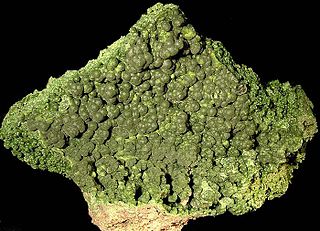
Mottramite is an orthorhombic anhydrous vanadate hydroxide mineral, PbCu(VO4)(OH), at the copper end of the descloizite subgroup. It was formerly called cuprodescloizite or psittacinite (this mineral characterized in 1868 by Frederick Augustus Genth). Duhamelite is a calcium- and bismuth-bearing variety of mottramite, typically with acicular habit.
Lahnsteinite is a basic sulfate mineral first discovered in the Friedrichssegen Mine, Germany in a goethite cavity. Though found in goethite, the crystals of Lahnsteinite are few millimeters in size, and are tabular shaped. Lahnsteinite was the first mineral discovered in the Lahn Valley deposits. The empirical formula for lahnsteinite is (Zn3.3,Fe0.27,Cu0.11)3.91(S0.98O4)(OH)5*3H2.10O.

Segnitite is a lead iron(III) arsenate mineral. Segnitite was first found in the Broken Hill ore deposit in Broken Hill, New South Wales, Australia. In 1991, segnitite was approved as a new mineral. Segnitite has since been found worldwide near similar locality types where rocks are rich in zinc and lead especially. it was named for Australian mineralogist, gemologist and petrologist Edgar Ralph Segnit. The mineral was named after E. R. Segnit due to his contributions to Australian mineralogy.

Queitite is a lead zinc silicate sulphate that was named after the mineral dealer Clive S. Queit, who collected the first specimens. It got approved by the IMA in 1979, and it is an extremely rare secondary mineral.
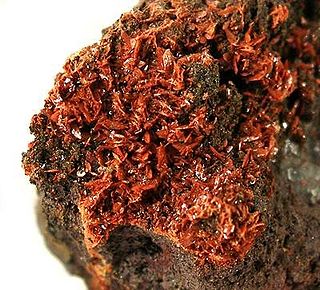
Mawbyite is a lead iron zinc arsenate that was named in honor of Maurice Alan Edgar Mawby. It has been approved by the IMA in 1988, and was published just a year after being described by Pring. Mawbyite is a member of the tsumcorite group, the monoclinic dimorph of carminite. It was first believed to be tsumcorite; however, crystal-structure determination showed iron and zinc occupying the same crystallographic site instead, and through the analysis it turned out mawbyite is isostructural with tsumcorite, meaning the two share a similar formula. More accurately, mawbyite appears to be the ferric analogue of the aforementioned mineral. The relationship between helmutwinklerite – which shares a similar formula with tsumcorite's – and mawbyite had been suggested, but due to lack of data it remains unclear. A full crystal-structure analysis is required in order to understand the relationship between their structures.


















